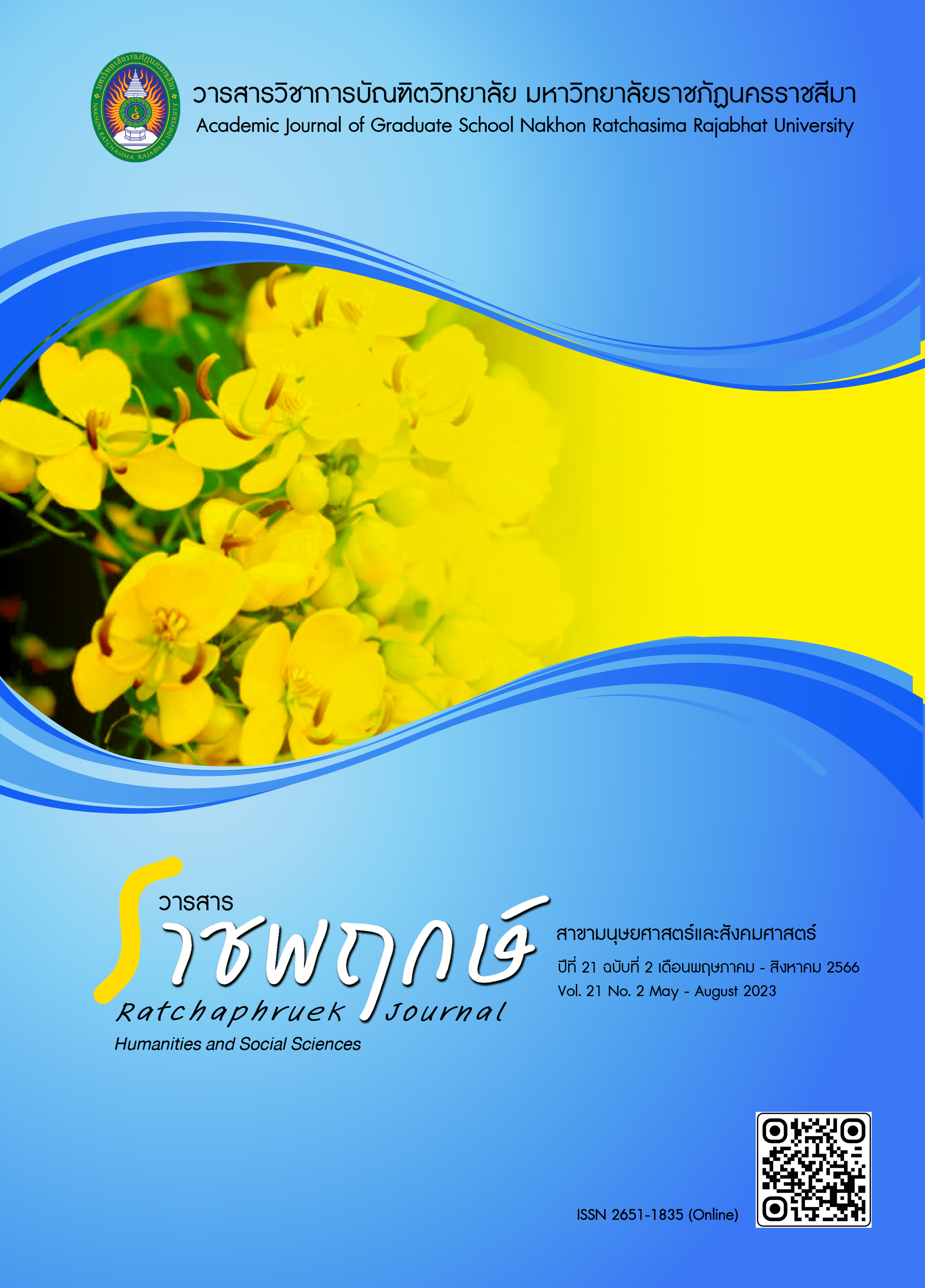The Factors Influencing the Paradigm of Religious Tourism: A Case Study of Wat Chedi (Ai Khai)
Main Article Content
Abstract
This research aimed to explore the demographic factors which influence the paradigm of studying belief and faith in sacred items when traveling for religious tourism. The sample group was Thai tourists who used to visit Wat Chedi (Ai Khai), Amphoe Sichon, Nakorn Sri Thammarat province for religious tourism. Purposive sampling was employed in this study. In total, 211 Thai religious tourists provided data. By using the quantitative research method, descriptive statistics were applied to analyze the characteristics of the participants. In addition, the One-way ANOVA test was employed to investigate the demographic factors of the participants which influenced the six paradigms. The questionnaire was the main instrument for collecting the data. By analyzing the demographic variables with the six approaches of the paradigm of studying belief and faith, the results revealed that the Structuralist Approach and the Symbolic/Interpretive Approach found no significant difference at the level of .05 (p < .05). However, the different genders were influenced the Functionalist Approach at a significant level of .05 (p < .05). While the difference in income levels was found to affect the Psychoanalytic Approach and the Cultural Ecology Approach at the significant level of 0.00 (p < .00), the Power/Knowledge Approach discovered a statistically significant relationship with the age and the income variables at the level of .00 (p < .00).
Article Details

This work is licensed under a Creative Commons Attribution-NonCommercial-NoDerivatives 4.0 International License.
References
กระทรวงการท่องเที่ยวและกีฬา. (2563). สรุปรายได้และค่าใช้จ่ายการท่องเที่ยวจากนักท่องเที่ยวชาวต่างชาติที่เดินทางเข้าประเทศไทย ปี 2562 (Tourism Receipts From International Tourist Arrivals). สืบค้นเมื่อ 11 พฤศจิกายน 2565, จาก https://www.mots.go.th/more_news_new.php?cid=615
ณพวัศกช์ เดชชาตรี, กฤตติกา แสนโภชน์, อรุณศรี อื้อศรีวงศ์ และธนกฤต ทุริสุทธิ์. (2560). ศึกษายุทธศาสตร์การจัดการแหล่งท่องเที่ยวในพื้นที่ศักดิ์สิทธิ์คำชะโนด อำเภอบ้านดุง จังหวัดอุดรธานี. วารสารมนุษยศาสตร์สังคมศาสตร์, 34(3), น. 224-246.
ธนิกานต์ มะรินทร์. (2559). การรับรู้ของประชากรศาสตร์ที่มีต่อการท่องเที่ยวเชิงศาสนาอย่างยั่งยืนกรณีศึกษา: วัดสมานรัตนาราม จังหวัดฉะเชิงเทรา (วิทยานิพนธ์มหาบัณฑิต, สถาบันบัณฑิตพัฒนบริหารศาสตร์).
นฤพนธ์ ด้วงวิเศษ. (2560). ศึกษาเกี่ยวกับแนวคิดมานุษยวิทยากับการศึกษาความเชื่อสิ่งศักดิ์สิทธิ์ในสังคมไทย. วารสารวิชาการมนุษยศาสตร์และสังคมศาสตร์, 25(47), น. 173-197.
นฤมล ทับปาน. (2563). ‘ไอ้ไข่’ วัดเจดีย์ นักปั้นเศรษฐกิจเมืองคอน. กรุงเทพธุรกิจ, สืบค้นเมื่อ 11 พฤศจิกายน 2565, จาก https://www.bangkokbiznews.com/news/detail/899054
ประชาชาติธุรกิจออนไลน์. (1 มกราคม 2564). เที่ยวไทย 63 สะดุด “โควิด” นักท่องเที่ยวต่างชาติหาย-รายได้เป็นศูนย์. ธุรกิจท่องเที่ยว, สืบค้นเมื่อ 13 พฤศจิกายน 2565, จาก https://www.prachachat.net/tourism/news-584487
ประเสริฐ เทพศรี. (1 ตุลาคม 2563). แรงศรัทธา! ‘ไอ้ไข่’ วัดเจดีย์ ชาวบ้านรอบวัดได้อานิสงฆ์เต็มๆ. The Bangkok insight, สืบค้นเมื่อ 13 พฤศจิกายน 2565, จาก https://www.thebangkokinsight.com/445882/
พรไพลิน จุลพันธ์. (9 พฤศจิกายน 2563). แรงศรัทธา “ไอ้ไข่” แอร์ไลน์เพิ่มรูท หนุนท่องเที่ยวนครศรีฯ โตพุ่ง. กรุงเทพธุรกิจ, สืบค้นเมื่อ 12 พฤศจิกายน 2565, จาก https://www.bangkokbiznews.com/news/detail/906736
พิเชฐ สายพันธ์. (2539). นาคาคติ อีสานลุ่มน้ำโขง ชีวิตทางวัฒนธรรมจากพิธีกรรมร่วมสมัย (วิทยานิพนธ์มหาบัณฑิต, มหาวิทยาลัยธรรมศาสตร์).
พิเชฐ แสงทอง. (2562). จาก “จตุคามรามเทพ” ถึง “ไอ้ไข่” จากการพึ่งอำนาจรัฐ สู่การพึ่งอำนาจราษฎร. RUSAMILAE JOURNAL, 40(2), น. 27-32.
สำนักข่าวกรมประชาสัมพันธ์. (2563). ททท. นครศรีธรรมราชกระตุ้นการท่องเที่ยว ชูความปลอดภัย ความสะอาด สู่มาตรฐาน SHA เพื่อการท่องเที่ยวที่ยั่งยืน. สืบค้นเมื่อ 11 พฤศจิกายน 2565, จาก https://thainews.prd.go.th/th/news/detail/TCATG201112132340494
สำนักงานสถิติจังหวัดนครศรีธรรมราช. (2563). สถานการณ์การท่องเที่ยวของจังหวัดนครศรีธรรมราช 2562. สืบค้นเมื่อ 11 พฤศจิกายน 2565, จาก http://nksitham.nso.go.th/index.php?option=com_content&view=article&id=954:2562&catid=85:2011-10-11-07-23-27&Itemid=513
สุมัยยา นาคนาวา. (2564). ทัศนคติพฤติกรรมและส่วนผสมทางการตลาดที่มีความสัมพันธ์และส่งผลต่อทัศนคติการใช้บริการร้านอาหารฮาลาลของผู้บริโภคที่ไม่ใช่มุสลิม (วิทยานิพนธ์มหาบัณฑิต, วิทยาลัยดุสิตธานี).
สุมาลี ไชยศุภรากุล. (2558). กระบวนทัศน์ในการวิจัยทางสังคมศาสตร์. วารสารจันทรเกษมสาร, 21(40), น. 1-8.
อนุกูล ตันสุพล. (2559). นิเวศวิทยาวัฒนธรรม: กุญแจสู่การพัฒนาที่ยั่งยืน. วารสารวิชาการคณะมนุษยศาสตร์และสังคมศาสตร์, 12(1), น. 193-221.
อานันท์ กาญจนพันธุ์. (2555). เจ้าที่และผีปู่ย่า: พลวัตของความรู้ชาวบ้าน อำนาจและตัวตนของคนท้องถิ่น. เชียงใหม่: ภาควิชาสังคมวิทยาและมานุษยวิทยา คณะสังคมศาสตร์ มหาวิทยาลัย เชียงใหม่.
Bowen, J. J. (2011). Religions in Practice: An Approach to the Anthropology of Religion. Boston: Prentice Hall.
Hair, J. F., Black, W. C., Babin, B. J. & Anderson, R. E. (2010). Multivariate Data Analysis (7th ed.). Upper Saddle River, NJ: Prentice Hall.
Hume, D. (1757). Dialogues Concerning Natural Religion and the Natural History of Religion. Oxford: Oxford University Press.
La Barre, W. (1970). The ghost dance: The origins of religion. Garden City, N.Y.: Doubleday.
Morris, B. (2006). Religion and Anthropology: A Critical Introduction. Cambridge: Cambridge University Press.


